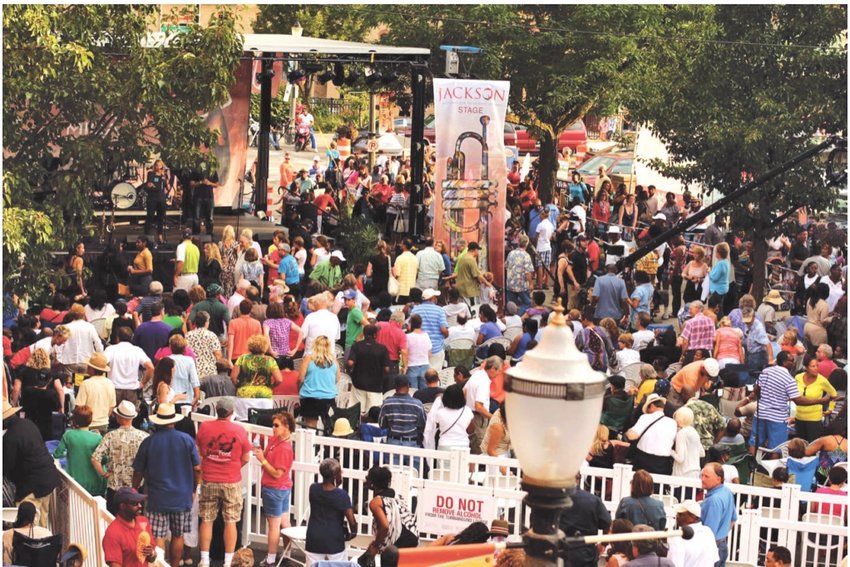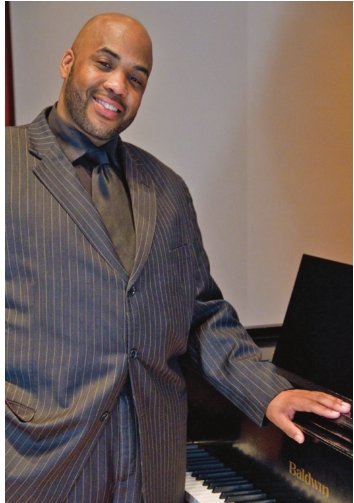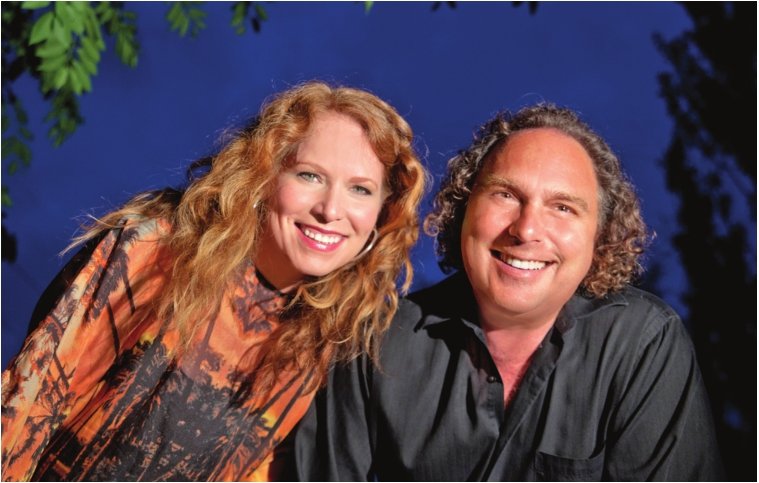
Lansing JazzFest, now in its 24th year, is about 10 festivals wrapped into one: a showcase for a great American art form, a celebration of Old Town’s vibrancy and growth, a chance to run into people and hug them, and a blissful street scene no other event in town can match.
There’s nothing like the groove that sweeps over Turner Street when the stars pop out and the horns start blowing over the orange bricks and glowering gargoyles of Old Town.
And there’s also a beer tent. Opportunities specific to this year’s festival include stellar guests like powerhouse Flint pianist/com poser Roger Jones and the New Orleans-based duo of vocalist Cindy Scott and guitarist Bran Seeger. (See related stories on these performers for an in-depth look.)
Among other highlights are the teaming of guitar virtuoso Elden Kelly with Detroit drum master Gayelynn McKinney; a quintet with a rare two-trombone front line (Sencalar/Glassman Quintet); the ringing Latin sound of Afro-Cuban dance ensemble Aguankó; and an afterglow late Saturday with Kalamazoo-based percussionist and bandleader Kevin Jones, who has played with artists as diverse as crooner Whitney Houston and avant-garde jazz firebrand Archie Shepp.
JazzFest also provides a well-deserved showcase for local pillars like father of the “Smooth Daddy” dance band, guitarist/bandleader Mike Daniels, the smoothand-beyond stylings of 496 West, the protean pianist Jeff Kressler and the LCC Jazz Band.
One of the tweaks in the ever-evolving festival is that nearby Cesar Chavez Plaza has reverted to a parking lot, to make parking easier for visitors. The vendors have moved north of the festival, on Turner Street.
There will be about 10 food vendors in all, from ice cream to Kingston Kitchen’s Jamaican food (new this year). Cocktails will brighten up the beer tent.
Between sets, visitors can duck into the MICA gallery on Turner Street to see the Leonard Freed photography exhibit, “Black in White America,” a penetrating look at race relations in the ‘60s. Some of the artists performing at this year’s JazzFest will hold workshops at nearby Sir Pizza and the Urban Beat performance venue.
Roger Jones: Room of mighty sound
The house of jazz has many mansions, from dance parties on the porch to chapels where devotional flames burn. Flint pianist, composer and teacher Roger Jones, a jazz and improvisation teacher at the Flint School for the Performing Arts, occupies a room of mighty sound that’s all his own.
Jones pours molten feeling into finely wrought original compositions that investigate the mysteries of life with slashing precision.
Every track on Jones’ epic album, “Higher Calling,” seems to wrestle with a crossroads in life, with titles like “Pushing Through,” “Moving On,” “New Territory” and “Where Do We Go From Here?” Jones brings his “Higher Calling” quartet to Lansing JazzFest Saturday at 9:30 on the Main Stage.
The no-nonsense titles telegraph that Jones’ music is direct and personal.
“My most profound writing and playing has not come from me sitting at the piano,” Jones said. “It’s when I’ve experienced something life-changing or cataclysmic.”
From the first note of “Moving On,” Jones comes down like a hammer and sets up a bass line of portentous, careful, heavy steps. “That song was when I broke up with a girlfriend and was moving on,” he said. “There’s anger in there, but by the time you get to the end, you hear resolution. Whether it’s conscious or subconscious, that stuff will come out.”
As a child, Jones was drawn to the Hammond B-3 organist who played at the church where his father was a pastor.
It’s not unusual to hear a story like that from a jazz musician, but this must have been a pretty hip church.
“The guy was heavily influenced by Billy Preston and Jimmy Smith,” Jones said with a laugh. Smith was the inventor of the hard-swinging jazz organ; Preston was the funky keyboardist who played with Sam Cooke, Rev. James Cleveland, the Beatles and the Rolling Stones.
“There was just something about it,” he said. “At eight or nine years old I started running to the piano and banging on it.”
His mother got a tip from a church lady on a beat-up old upright piano and set him up. He started listening to jazz on Flint public radio and got deeper into the music.
In his junior year of high school, he went to Interlochen and met a lot of jazz musicians from around the country.
When it comes to personal influences, Miles Davis’ great quintet with Herbie Hancock and John Coltrane’s quartet with McCoy Tyner are at the top.
Those are some of jazz’s heaviest hitters, but lightweight stuff doesn’t seem to interest Jones.
He builds his tunes on frameworks of iron and fills them with lava. His grand gestures and dark cross-currents are inspired, in part, by the most expressive and lyrical titans of classical music.
“I’m a big Rachmaninoff fan,” he said. “Samuel Barber, Shostakovich and even Beethoven — when I listen, I wonder what they were going through that made them write what they did.”
In “Where Do We Go From Here?” he rolls an insistent, question-like melody around and around until an energized, Thelonious Monk-like phrase — a possible answer — pops out of his piano, setting the quartet on a swinging, headlong rush that only leads back to the question.
It’s a Mobius strip microcosm of life, but Jones said the structure was sculpted in the studio as they were working out the tune. As a composer, he is always forging chains for the quartet to strain against, and, on occasion, break.
“There’s always a reference point, where it’s not totally free, but you have freedom within the constraints that set you free — if that makes sense.”
Cindy Scott and Brian Seeger: In the zone
Cindy Scott sings with a breezy, sunlit style that belies her exacting vocal craftsmanship. Brian Seeger’s sensitive guitar is a perfect match, rippling like generous layers of sea and sky behind Scott’s voice as it reaches full sail.
After 10 years together, the New Orleans duo has mastered their own stretch of open water, the isthmus between jazz standards, American roots music and original singer-songwriter-style tunes.
They leave the jazz purism to others and weave all their favorite music into a seamless whole, but it’s not as easy as they make it look.
“We work at being seamless,” Scott said. “We try to present ourselves, something that’s deeper or more personal, no matter what kind of show we’re doing.”
Seeger believes that he and Scott are not unique in playing down the “jazz” side of being jazz musicians.
“The old cats here in New Orleans, like Ellis Marsalis, never thought of themselves as jazz musicians or blues musicians, just musicians,” he said. “They just played music and loved being with each other.”
Saturday at 7:30 on the Main Stage, they’ll mix some original tunes, including some recent arrangements specially tailored to the band they are bringing to Old Town.
A notable member of that band is pianist Ron Newman, a local legend and husband of vocalist Sunny Wilkinson, who will also pop up on stage to join the music making. (The four of them hit it off and are fast friends.)
At JazzFest, Scott and Seeger will skew toward jazz, of course, but always with a few surprises.
“That’s one of the beautiful things about deciding you just love music for music’s sake,” Scott said. “You don’t really have to decide to be just one thing.”
Scott’s family is a tangle of musicians from way back.
“My mother had an amazing ear and ended up subbing for Hank Williams, Sr.’s piano player on a radio show in Montgomery,” Scott said. “She was about 16 and didn’t really appreciate what he was. They asked her to go on tour with the band and she was like, ‘Uh, no, I don’t think so.’” Her dad played 20 instruments — pretty much whatever he cared to pick up. “His background was more earthy, and salty, whatever he liked on the radio,” Scott said. “My mother taught me to sing ‘Hello Dolly’ so she could present me at a party. It was just part of the fabric of our lives.”
Seeger’s background is completely the opposite. Nobody in his family played music and they couldn’t figure out why he loved it so much.
“It was kind of a mystery to my family,” Seeger said. “When I was two, I was super fascinated with the radio. I can still see the radio in my mind.”

Seeger’s family was from the Detroit area but moved South when he was one year old. He remembers a collection of Motown records in the house.
“I learned how to operate the record player when I was 6,” he said. “I listened to the records over and over and announced to my folks when I was 7 that I wanted to be a saxophonist. They didn’t really comprehend that I was into music that much.”
His parents steered him toward guitar because a lady at church was available to give lessons.
“I was like ‘OK, if that’s my only option,’” Seeger said with a laugh. “So I’m a frustrated saxophone player, but that’s part of why I’ve been so attracted to jazz.”
Seeger did a lot of work in the 90s as a sideman, running around between many projects, and longed for a deeper musical relationship.
“I’ve whittled my life down to mostly doing musical projects where there’s some deep connection,” he said. “Being in the zone is incredibly important to me. You can do it when you’re playing with strangers, but there’s so much more you have to manage in that situation, to find that place. We can be insanely in the zone.”
“We talk about that all the time,” Scott said. “We’ll be bitching one minute and then saying ‘We don’t want to do anything else.’”
Lansing JazzFest Aug. 3 and 4
Old Town Lansing See pages 13 to 16 for complete details.
Support City Pulse - Donate Today!
Comments
No comments on this item Please log in to comment by clicking here